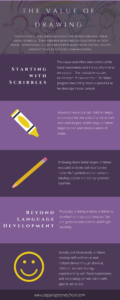The Value of Drawing
Starting with Scribbles
Handing a child a crayon for the first time is a game of chance often ending with the removal of crayon wax from his mouth. However, once he is taught to use crayons with paper rather than as a teething toy, he soon notices the cause and effect relationship between his hand movements and the colorful marks on a paper. The realization causes exhilaration: “I have control.” Scribbles progress becoming more purposeful as he develops motor control.
Around three and a half, children begin to connect the two ends of a line to form enclosed shapes. At this stage, children begin to plan and create a sense of order. As a child combines shapes, his pictures take on meaning. His first attempts to represent real-world objects through his drawing. (Striker, 2001)
The developmental stages of drawing are included in the progression of writing. Following those initial stages, children exposed to letters will incorporate “letter-like” symbols in their artwork – labeling objects and stringing letters together. Verbal children often relate narratives based on their drawing when prompted with statements like, “tell me about your picture.”
Beyond Language Development
The developmental benefits of drawing do not end there. Physically, drawing enables children to develop hand-eye coordination, fine and gross muscle control, and finger dexterity.
Socially and Emotionally, children develop self-confidence and independence through drawing. Children explore feelings experimenting with facial expressions and associating certain colors with specific emotions (Ex. yellow symbolizing happiness and blue representing sadness). Children learn how to share materials and take turns talking about their creations.
Cognitively, children represent the world around them using symbols. They observe how objects function as they draw. Additionally, children experiment with colors, shapes, and patterns in various combinations. (Steel, 1997)

Promoting Drawing
To encourage children to draw:
- Vary the materials. Young children experimenting with drawing are excited to try their skills in different ways. Varying materials, exchanging markers for chalk and crayons for pens or pencils create exciting new experiences.
- Discuss the process, not the product. Talk about the colors or the kinds of lines and shapes your child has made in her picture. By focusing on the process, she is encouraged to continue to create and add details, instead of providing a product.
- Give Freedom. When children are given a blank paper to draw rather than coloring books, children experiment with lines, shapes, and colors receiving all the benefits previously described. At Stepping Stone School, we call this open-ended art.
When children are provided with freedom in their drawing, creativity is nurtured and imagination unleashed. This is the value of drawing.
Resources:
Adoniou, M. (2016, September 1). What can we learn from children’s drawings? Retrieved from https://theconversation.com/what-can-we-learn-from-childrens-drawings-64527
Crosser, S. (n.d.). When Children Draw. Early Childhood News. Retrieved from http://www.earlychildhoodnews.com/earlychildhood/article_view.aspx?ArticleID=130
Fattal, I. (2017, Oct. 25). The Hidden Meaning of Kids’ Shapes and Scribbles. The Atlantic. Retrieved from https://www.theatlantic.com/education/archive/2017/10/the-hidden-meaning-of-kids-shapes-and-scribbles/543873/
Hunter, S. (2012). 5 Reasons Drawing is Important for Your Child’s Development. Retrieved from https://www.kiwifamilies.co.nz/2012/06/why-drawing-important-childrens-development/
Steel, B. (1997). Developmental Stages of Children’s Drawings. Draw Me A Story: An Illustrated Exploration of Drawing-As-Language. Retrieved fromhttp://www.earlychildhoodcentral.org/childrens-art/developmental-stages
Striker, S. (2001). Young at Art: Teaching Toddlers Self-Expression, Problem-Solving Skills, and an Appreciation for Art. New York: Holt Paperbacks.